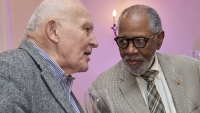History

On January 15, 1945, the Psychoanalytic Clinic for Training and Research was established in the Department of Psychiatry of the Columbia University College of Physicians and Surgeons. It was the first psychoanalytic institute affiliated with the American Psychoanalytic Association to be established in a university and medical school. Drs. Sandor Rado, George E. Daniels, David Levy, Abram Kardiner, and Nolan D. C. Lewis were responsible for founding the Center, and Dr. Rado became the Center’s first director. Dr. Viola Bernard assisted him in the development of the Center’s first curriculum.
The Clinic was founded with the belief that psychoanalytic training could be enriched in a setting with biological and medical-scientific disciplines on the one hand and its links to the social sciences and humanities on the other. A department of psychiatry in a medical school would provide access to patients and opportunities for education and research, while a university affiliation would allow collaboration with the larger academic community. This collaborative spirit has been at the heart of Columbia's psychoanalytic program ever since.
Psychoanalysis
Psychoanalysis was defined by Freud in three ways. First, it is a theory of human behavior. Second, it is a treatment. Third, it is a method for the investigation of unconscious and conscious mental processes, a special kind of research instrument. Education at Columbia is concerned with all three facets of psychoanalysis. As a theory of the mind, psychoanalysis emphasizes the importance of unconscious mental life and the central importance of conflict, conscious and unconscious. It takes into account the interaction of biological sources of human motivation along with cultural forces and factors that influence the development of mental structure and function.
As a treatment, psychoanalysis focuses on the unconscious determinants of the interaction of the patient with the analyst. Transference, resistance, countertransference, interpretation, insight, empathy, and working through are major elements in the study of therapeutic process and change.
Research
Psychoanalytic research is also a crucial mission at the Center. Research projects have included such varied topics as psychosomatic illness, gender identity, body image disorders, anorexia nervosa, male and female sexuality, psychoanalytic education, infant development, dreams, character organization, ego-strength, aesthetics, creativity, fantasy, psychobiography, literature, the influence of culture on personality, psychonalysis and medication, and the development of analytic identity (link to 3.1). Psychoanalysis as a treatment has been an object of study in work on social class and psychoanalytic therapy, outcome results of psychoanalytic treatment, comparative treatment of patients with phobias and panic disorders, and the effects of low-cost clinic fees.
Candidates are actively encouraged to develop new projects themselves and to participate in the ongoing work of the research committee.
At Columbia, we believe that theoretical pluralism strengthens both psychoanalytic training and psychoanalytic treatment. Thus, we encourage our faculty and candidates to teach and study a divergence of viewpoints. Our selection of both candidates and faculty members reflects this educational and therapeutic philosophy.
PAST DIRECTORS
Sandor Rado, 1945-1955
Abram Kardiner, 1955-1957
George Daniels, 1958-1961
George Goldman, 1961-1971
Aaron Karush, 1971-1976
John Weber, 1976-1981
Ethel Person, 1981-1991
Roger MacKinnon, 1991-1996
Robert Glick, 1997-2007
Eric Marcus, 2007-2017
Susan Vaughan, 2017-2023
Justin Richardson, 2023-